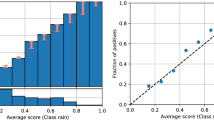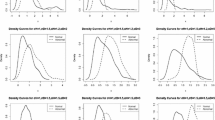Abstract
Obtaining calibrated probability, or actual occurrence, is crucial in many real problems because it effectively supports the decision-making process with good assessment of cost and effect. Estimating calibrated probability is a more significant issue in class imbalance and class overlap problems, where direct application of classification algorithms may result in substantial errors. Consequently, several post-processing calibration techniques that aim at improving the probability estimation or the error distribution of existing classification models have been developed. In this underlying context, we propose Receiver Operating Characteristics Binning, a robust method that provides accurate calibrated probabilities that are robust to changes in the prevalence of the positive class by using a combination of True Positive Rate, False Positive Rate, and the prevalence of the positive class. The results of experiments conducted on the real-world UCI dataset indicate that, given a training set in which the positive class proportion is noticeably different from that of the test set, the proposed ROC Binning method outperforms conventional calibration methods.








Similar content being viewed by others
References
Bella A, Ferri C, Hernández-Orallo J, Ramírez-Quintana MJ (2013) On the effect of calibration in classifier combination. Appl Intell 38(4):566–585
Naeini MP, Cooper GF, Hauskrecht M (2014) Binary classifier calibration: non-parametric approach. arXiv preprint arXiv:14013390
Zadrozny B, Elkan C (2001) Obtaining calibrated probability estimates from decision trees and Naïve Bayesian classiers. In: Proceedings of the 18th international conference on machine learning, Williamstown, MA, 2001. pp 609–616
Platt J (1999) Probabilistic outputs for support vector machines and comparisons to regularized likelihood methods. In: Advances in Large Margin Classifiers, pp. 61–74
Zadrozny B, Elkan C Transforming classifier scores into accurate multiclass probability estimates. In: Proceedings of the 8th ACM SIGKDD international conference on Knowledge discovery and data mining, Canada, 2002. pp 694–699
Agoritsas T, Courvoisier DS, Combescure C, Deom M, Perneger TV (2011) Post-test probability according to prevalence. J Gen Intern Med 26(10):1091. doi:10.1007/s11606-011-1787-5
Denil M, Trappenberg T (2010) Overlap versus imbalance. Advances in artificial intelligence. Springer, Berlin Heidelberg, pp 220–231
Cohen I, Goldszmidt M (2004) Properties and benefits of calibrated classifiers knowledge discovery in databases: PKDD 2004, Lecture Notes in Computer Science
Sun M, Choi K, Cho S (2015) Estimating the minority class proportion with the ROC curve using Military Personality Inventory data of the ROK Armed Forces. Journal of Applied Statistics 42(8):1677–1689
Lambrou A, Papadopoulos H, Nouretdinov I, Gammerman A (2012) Reliable probability estimates based on Support Vector Machines for large multiclass datasets. Artif Intell Appl Innov 382:182–191
Wallace BC, Dahabreh IJ (2012) Class probability estimates are unreliable for imbalanced data (and how to fix them). In: IEEE 12th international conference on data mining, Washington, DC, 2012. IEEE Computer Society, pp 695–704
Lin H-T, Lin C-J, Weng RC (2007) A note on Platt’s probabilistic outputs for support vector machines. Mach Learn 68(3):267–276
Fawcett T, Niculescu-Mizil A (2007) PAV and the ROC Convex Hull. Mach Learn 68(1):97–106
Niculescu-Mizil A, Caruana R (2005) Predicting good probabilities with supervised learning. In: Proceedings of the 22nd international conference on Machine learning, 2005. ACM, pp 625–632
Gebel M (2009) Multivariate calibration of classifier scores into the probability space. Dissertation, Technical University of Dortmund, Duisburg, Germany
Ferri C, Hernández-Orallo J, Modroiu R (2009) An experimental comparison of performance measures for classification. Pattern Recogn Lett 30(1):27–38
Brier G (1950) Verification of forecasts expressed in terms of probabilities. Mon Weather Rev 78:1–3
Murphy AH (1973) A new vector partition of the probability score. J Appl Meteorol 12(4):595–600
Flach P, Matsubara ET (2007) A Simple Lexicographic Ranker and Probability Estimator. Machine Learning: ECML 2007 Lecture Notes in Computer Science 4701:575–582
Murphy AH (1972) Scalar and vector partitions of the probability score: part ii. n-state situation. J Appl Meteorol 11:182–1192
Fawcett T (2006) An introduction to ROC analysis. Pattern Recogn Lett 27:861–874
López V, Fernández A, Moreno-Torres JG, Herrera F (2012) Analysis of preprocessing vs. cost-sensitive learning for imbalanced classification. Open problems on intrinsic data characteristics. Expert Syst Appl 39:6585–6608
Barranquero J, González P, Díez J, Coz JJ (2013) On the study of nearest neighbor algorithms for prevalence estimation in binary problems. Pattern Recogn 46:472–482
Forman G (2008) Quantifying counts and costs via classification. Data Mining Knowl Discov 17:164–206
Webb G, Ting K (2005) On the application of ROC analysis to predict classification performance under varying class distributions. Mach Learn 58:25–32
Fawcett T, Flach P (2005) A response to Webb and Ting’s on the application of ROC analysis to predict classification performance under varying class distributions. Mach Learn 58(1):33–38
Tan P-N, Steinbach M, Kumar V (2006) Introduction to data mining. Addison Wesley, New York
Lichman M (2013) UCI machine learning repository (http://archive.ics.uci.edu/ml). University of California, Irvine, School of Information and Computer Sciences, Irvine, CA
Sánchez JS, Mollineda RA, Sotoca JM (2007) An analysis of how training data complexity affects the nearest neighbor classifiers. Pattern Anal Appl 10(3):189–201
Duda RO, Hart PE (1973) Pattern classification and science analysis. Wiley, New York
Switzer P (1980) Extensions of linear discriminant analysis for statistical classification of remotely sensed satellite imagery. J Int Assoc Math Geol 12(4):367–376
Agresti A (1996) An introduction to categorical data analysis. Wiley, New York
Cortes C, Vapnik VN (1995) Support-vector networks. Mach Learn 20(3):273–297
Matlab version 7.10.0 (2010). The MathWorks Inc., Natick, Massachusetts
Isotonic Regression Software (2005) undInstitute für Mathematische Statistik und Versicherungslehre. Universität Bern, Bern
Demšar J (2006) Statistical comparisons of classifiers over multiple data sets. J Mach Learn Res 7:1–130
Author information
Authors and Affiliations
Corresponding author
Electronic supplementary material
Below is the link to the electronic supplementary material.
Rights and permissions
About this article
Cite this article
Sun, M., Cho, S. Obtaining calibrated probability using ROC Binning. Pattern Anal Applic 21, 307–322 (2018). https://doi.org/10.1007/s10044-016-0578-3
Received:
Accepted:
Published:
Issue Date:
DOI: https://doi.org/10.1007/s10044-016-0578-3




